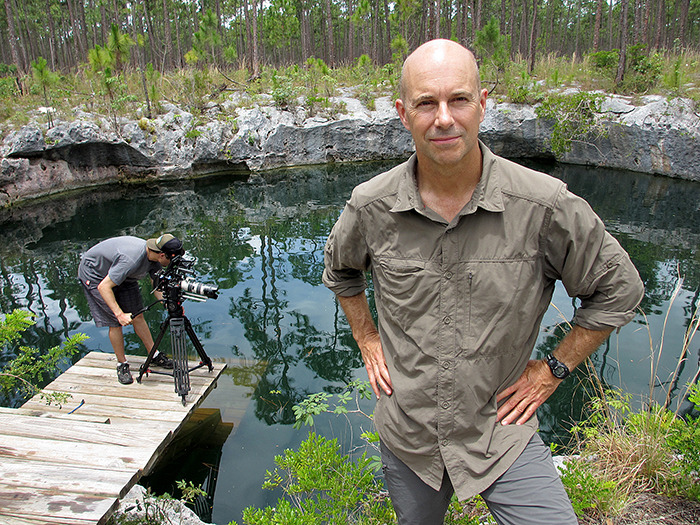
We were pleased to be invited to participate in the first 3D[FWD] Conference held last Friday at the Vancity Theatre. The conference kicked off the creation of the first Canadian branch of the International 3D Society and present insight into the 3D business for those foraging forward.
Here’s a short rundown on some of the speakers:
David Brenner, CEO of LA-based Principal Media outlined models of financing 3D productions. Principal claims to be the world’s largest distributor of 3D content. David was clear that it was difficult to fund exclusively 3D content. It was interesting that he recommended that producers pursue a 2D/3D model to create content, to serve both broadcast platforms as we did with our 3D Blowdown episode. David also shared information about an additional revenue stream through VOD apps by television manufacturers that could also generate revenue for even short form content. For anyone in possession of spectacular stereoscopic imagery of any length, this seems like a viable option.
David also provided projections for the penetration of 3D televisions. It is estimated that by 2016, 50% of American homes will have 3D-ready sets. Panasonic has already announced that 90% of the televisions it is already producing are 3D capable.
After the coffee break, there was a great panel discussion entitled “Telling Your Story in 3D.” Moderated by Buzz Hays, founder of True Image Company. The panel included Adam May from Vision3, Joshua Hollander out of Pixar and Robert Neuman of Disney Animation Studios. They shared beautiful samples of their work and lots of discussion about the practical implications of working in 3D both in live action and animation. For me, the greatest part was the reassurance that everyone, regardless of the size of their budgets or the depth of corporate support, has been working things out. Building as we are on a century-old tradition of cinema, it was reassuring to learn that we’re all still learning to master the language of 3D. The exciting part for the audience is that 3D is only going to get better and better as we move through this rapid experimental stage.
After lunch, Parallax Film’s Ian Herring teamed up with James Cowan of Finale Editworks to discuss the reality of producing the 3D content in Vancouver. Readers of our blog will remember the challenges we encountered producing a 3D episode of our Blowdown series.
The session presented by Vancouver based Gener8 was a real eye opener for us. We’ve always had a negative knee jerk reaction about 2D-to-3D conversion, arguing that poor conversions reflected badly on the industry. However, Gener8 made a strong argument for the service they provide. While some movies are entirely converted, Gener8 has also worked on a number of films that were shot native 3D, but pick ups were in 2D, sometimes for reasons of costs. Mark Lasoff and Colin Jenken also argued that given the complexity of some sequences, combining live action 3D, computer generate imagery (CGI) and visual effects, it may be almost impossible to shoot these sequences in 3D and have the components come together successfully. Conversion is viable option.
It was a treat to hear Hugh Murray speak about IMAX’s experiences with 3D. Dating back into the 1980s, IMAX provided many people with their first exposure to 3D films. The technological challenges have been immense, as they not only developed camera systems but also the theatre venues in which the films could be shown. Samples from their recent 3D space films seemed to capture the aspirational aspects of both the voyages of discovery and the visual media with a nod to IMAX’s Canadian roots.
James Stewart of Geneva Film Co shared some of his work producing commercials for companies like Telus and this classic moment from the Honeymooners:
James provided us all with the talking points to sell our media form, reminding us all that if 3D is a fad, it is a 227.27 BILLION dollar fad, that is growing at 15% per year.
The last official presentation of the day was Grant Anderson of the Sony 3D Technology Centre. He presented a series of three case studies in which they shot existing or new projects using 3D cameras. Overall, he found that they were able to get their crews up to speed with a day or two of training, with only modest increases to the labour required for the shoot, usually three extra bodies.
In all his recommendations included:
- Plan 3D aspects (including depth cues) ahead of time.
- Understand how to shoot for the 3D screen the audience will watch on.
- Quick set up and calibration, checked throughout the day and
- Know what good 3D looks like and don’t leave with out it.
The results of the white paper on 3D at 2D Economics is available here.
Special thanks to everybody who made this conference happen. The day flew by and they did an excellent job bringing together a varied group with plenty of insight. A special mention goes out to the tech people who made it possible for all the speakers to share their 3D content with the audience at the Vancity Theatre.


